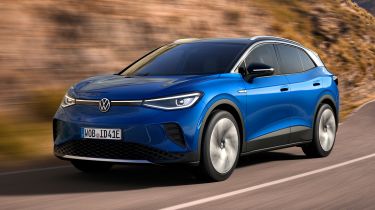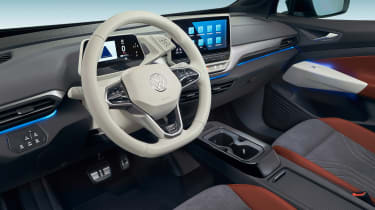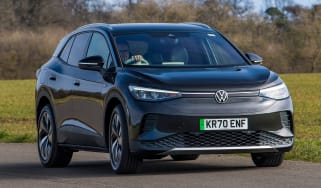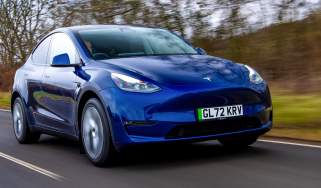Volkswagen ID.4 lineup gains new City and Style variants
Entry-level Volkswagen ID.4 City model qualifies for UK’s amended plug-in car grant
Volkswagen has added two new variants to its ID.4 SUV range. Called City and Style, they take the ID.4’s trim levels to seven, including the soon on sale, hot GTX version.
The City variant will be the new entry-level model and it qualifies for the government’s re-jigged plug-in car grant, dropping the ID.4 starting price to £32,150. The Style comes with more equipment as standard and starts from £38,150.
Both the City and Style can be had with what VW calls the Pure and Pure Performance powertrains. For both, the battery has a 52kWh capacity - somewhat smaller than the 77kWh cell found in the Life, Family and Max models. It is linked to an electric motor developing 146bhp in Pure guise, or 168bhp in the Pure Performance version.
Choosing the entry-level City model with the 168bhp powertrain bumps the price up to £36,030, while in the Style model the price rises to £39,530. The City model offers 213 miles of range on the WLTP cycle compared to the Style’s 211 miles. All versions come with 100 kW rapid charging capability.
The City model gets 10-colour ambient lighting, a 10-inch infotainment screen and driver assistance systems including; lane assist and adaptive cruise control. To set the Style model apart from the City version, it gets larger 18-inch alloy wheels, ‘IQ.Light’ headlights, tinted windows, three-zone climate control and a rear-view camera.
These new models follow on from the launch-spec ID.4 1st Edition, Life, Family and range-topping Max. The 1st Edition is £40,800, Life is £41,570, the Family £45,520 and Max comes in at £49,990.
Upgrades for the 1st Edition include ‘1st Edition’ badging and 20-inch rims. Life models get heated front seats, a leather wrapped heated multifunction steering wheel and a wireless smartphone charger. Family versions receive a panoramic glass roof and Max models get 12-way electrically adjustable sports seats with memory and massage functions, a 12-inch touchscreen, a head up display as well as adaptive dampers and an automatic tailgate.
The ID.4 Max also features some extra safety equipment, including lane assist, a 360-degree camera and Volkswagen’s semi-autonomous Travel Assist driving function, which allows the SUV to assume control of its steering, brakes and accelerator on motorways for short periods of time.
Volkswagen offers a handful of optional extras, including a silver roof (£620), a tow-bar and a choice of alloy wheel designs, ranging in size between 18 and 21 inches. Buyers can also swap the standard ID.4’s steering wheel for a white replacement at no extra cost.
For now, the more expensive Life, Family and Max variants are only available with Volkswagen’s Pro Performance electric powertrain, which comprises a 77kWh battery and a rear-mounted electric motor with 201bhp and 310Nm of torque. Life models have a maximum range of 323 miles, while Family and Max variants can manage 318 and 314 miles respectively on a full charge.
The powertrain gives the ID.4 a 0-62mph time of 8.5 seconds and a top speed of 99mph remains the same across the ID.4 range. The SUV’s electrical architecture also accepts 125kW DC rapid charging, meaning the battery can recover almost 200 miles of range in just 30 minutes.
A range-topping all-wheel drive version called the GTX has already been revealed. It’ll borrow its drivetrain from the Skoda Enyaq vRS, for a maximum output of 302bhp, a 0-62mph time of just 6.2 seconds and a limited top speed of 112mph. The GTX also offers a range of up to 298 miles. Prices are expected to be around £43,500.
New Volkswagen ID.4: design and proportions
As the second model in Volkswagen’s all-electric ID line-up, the ID.4 consolidates the design language and themes introduced by the ID.3, morphing many elements of the firm’s electric hatchback into a larger SUV package. As such, much of the exterior is recognisable.
The ID.4’s surfacing is clean like on the ID.3 hatchback – and the headlights, with their interactive IQ. Light LED units, form a full-width light bar and a blunt, grille-free front end. Its glasshouse is large with a windscreen stretching far towards the front axle, and the shoulder line is reminiscent of its smaller sibling too.
Volkswagen did fit a different tailgate and rear light bar to the crossover, along with a few SUV touches, such as wheel arch cladding and a more protruding rear window – all of which helps to give the ID.4 a more boxy SUV shape.
Against the tape measure, the ID.4 is 4,580mm long, placing it between the regular Tiguan and the seven-seat Tiguan Allspace in terms of length. Boot space comes in at 543 litres with all seats in place, or 1,575 litres with the rear seats folded down.
New 2020 Volkswagen ID.4: interior and technology
A wheelbase of 2,700mm, in combination with the under-floor packaging of the battery and the rear-axle mounted electric motor, means that Volkswagen can claim the ID.4 has almost as much room inside as cars from the segment above.
The dashboard is familiar, borrowing plenty from the ID.3 hatchback. A thin centre console with cupholders and storage spaces sits low between the driver and passenger, and the dashboard is defined by angular vents and lines.
However, the most prominent features are the screens. There’s a central infotainment display measuring 10-inches across (although this is replaced by a 12-inch screen on top spec cars) and a small digital instrument panel. Both can be operated through Volkswagen’s new “Hello ID” voice control system.
The ID.4 introduces a new augmented reality head-up-display. This is capable of projecting 3D graphics onto the windshield as if they are objects on the road ahead, such as navigation prompts to show you exactly which lane you should be in at a roundabout.
Unlike the ID.3 hatchback, the ID.4 is available with adaptive dampers and dynamic chassis control. Lane keep assist and automatic emergency braking will be standard, while adaptive cruise control will be offered, as will the latest version of Volkswagen’s Travel Assist semi-autonomous driving assistant.
Click here to read our review of the new Volkswagen ID.3...











